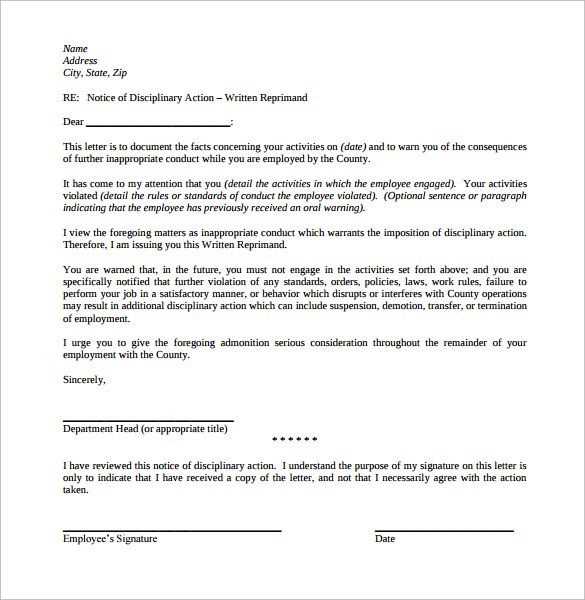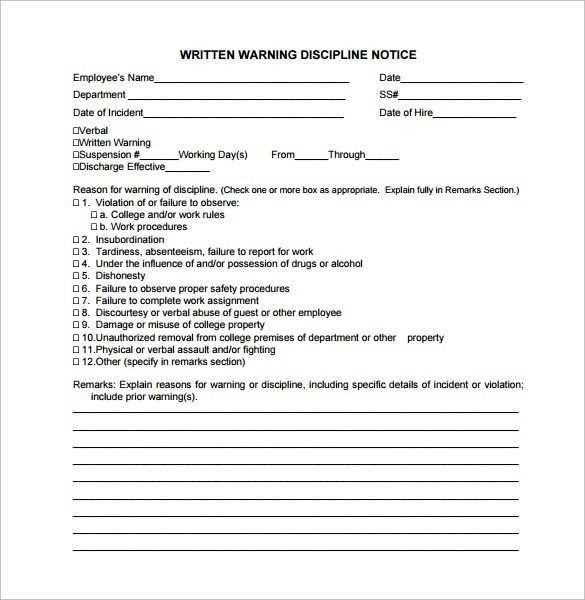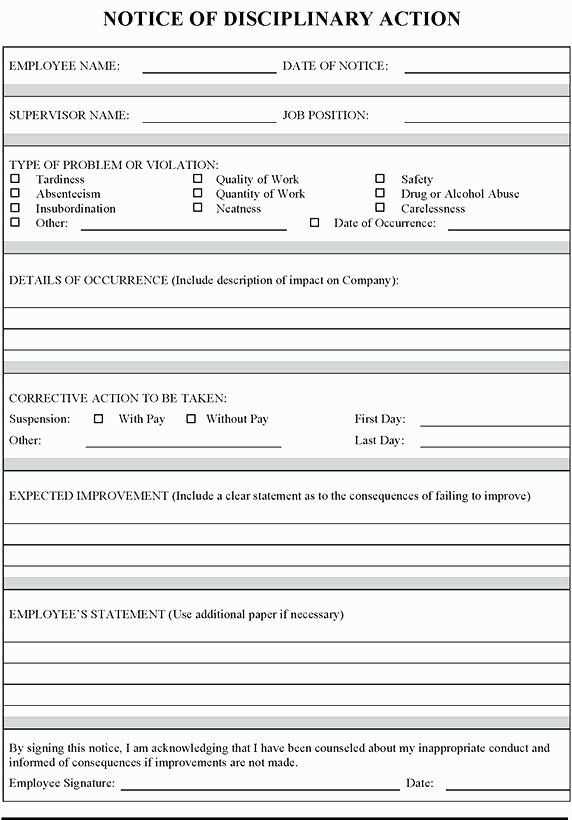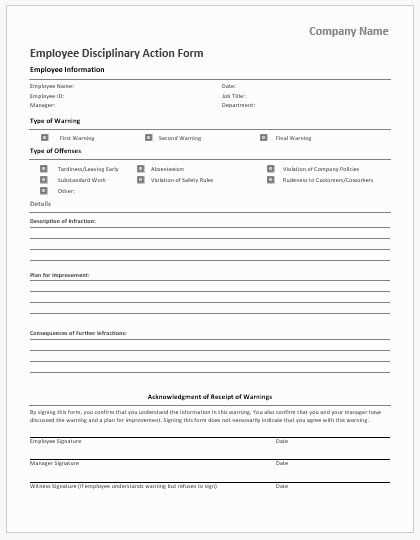Employee disciplinary letter template

Addressing employee behavior issues requires a clear, formal approach. A well-crafted disciplinary letter not only outlines the problem but also provides a path for resolution. Use the following template to communicate expectations and next steps, ensuring transparency and fairness in the process.
Start with a direct statement of the issue. Clearly describe the behavior or performance concern that prompted the disciplinary action. Avoid ambiguity–state facts and provide specific examples to make the situation clear. For instance, if an employee consistently misses deadlines, mention the dates and impact this has had on the team’s productivity.
Follow with the expectations and consequences. Remind the employee of the company’s standards and the expectations for their conduct. Be specific about the improvement required and the timeline for achieving it. Clearly outline any further steps or consequences if the issue isn’t addressed, such as probation or termination.
End with a constructive note, offering support if applicable. If the employee is willing to work toward improvement, reassure them that help and resources are available, whether through additional training or regular check-ins with their supervisor.
Employee Disciplinary Letter Template
Start by clearly stating the purpose of the letter. Address the specific behavior or action that led to the disciplinary action, and outline the date or time frame when the incident occurred. Use precise language to describe the issue, avoiding generalizations or vague statements.
Example: “This letter serves as a formal notice regarding your repeated lateness to work. On three separate occasions over the past two weeks, you arrived more than 30 minutes late without prior notification.”
Next, explain how the behavior violates company policies or affects the workplace. Refer directly to the relevant rules, codes of conduct, or previous warnings, if applicable. It’s important to connect the action to specific expectations and consequences.
Example: “According to the company’s attendance policy, employees are expected to be at work on time, and failure to comply may result in disciplinary action. Your tardiness is disrupting the team’s workflow and affecting overall productivity.”
State the consequences of continued behavior, outlining the specific steps that will be taken if the issue persists. This can include further disciplinary measures such as suspension or termination. Be firm, but avoid sounding threatening. Aim for clarity and transparency.
Example: “If this issue continues, you will face further disciplinary actions, which may include suspension or termination of employment.”
End the letter by offering the employee an opportunity to explain or discuss the situation. This shows fairness and encourages open communication. Mention that the employee can contact HR or their supervisor to discuss the matter further.
Example: “We invite you to meet with your supervisor to discuss this issue. If you have any questions or concerns, please reach out to HR to schedule a meeting.”
Close the letter by reiterating the importance of improving the behavior and maintaining a professional work environment. Sign the letter with the appropriate contact details and indicate that the employee’s acknowledgment is required.
Example: “We expect your immediate improvement in this matter. Please sign and return a copy of this letter as acknowledgment of receipt.”
Key Components of a Disciplinary Letter
Begin by clearly stating the reason for the disciplinary action. Specify the exact behavior or actions that led to the decision, including dates and times where applicable. This section should avoid generalities and focus on observable facts to ensure the employee understands the context of the issue.
Details of the Violation
Describe the specific incident or pattern of behavior that triggered the letter. If this relates to a policy violation, refer directly to the relevant rules or guidelines that were not followed. Avoid ambiguity and provide clear evidence, such as witnesses or documentation, to support your claims.
Consequences and Expectations
Outline the consequences of the behavior. This includes any immediate actions being taken, such as suspension, warnings, or other measures. Then, set clear expectations for future conduct. Include the steps the employee must take to avoid further disciplinary actions, and specify any changes in behavior, performance, or compliance required.
Close with a reminder of the importance of upholding company standards and maintaining a positive work environment. Reinforce the company’s commitment to fairness and transparency in handling disciplinary matters.
How to Address the Employee’s Specific Misconduct

Clearly outline the incident, specifying the actions or behaviors that led to the misconduct. Be direct and avoid ambiguity. Providing exact examples ensures the employee understands the severity of their actions and what went wrong.
Identify the impact of the behavior on the team, company, or customers. Explaining the consequences reinforces the seriousness of the issue and can help the employee see the bigger picture.
Steps to Take When Addressing the Misconduct

| Step | Action | Purpose |
|---|---|---|
| 1 | Document the Incident | Provide clear examples of misconduct for transparency. |
| 2 | State Expectations | Clarify the company’s rules and policies that were violated. |
| 3 | Offer Guidance | Suggest how to improve or correct the behavior. |
| 4 | Follow-Up | Ensure the employee has the opportunity to correct their behavior. |
Focus on Constructive Actions
Rather than focusing solely on the negative aspects of the misconduct, make it clear that improvement is possible. Provide actionable steps for the employee to follow. It’s vital to encourage the employee to take responsibility while showing support for their growth and development.
Setting Clear Expectations for Improvement

Define specific goals for improvement. Outline measurable targets that are realistic and aligned with the employee’s role. Break down these goals into manageable steps that can be achieved within a set timeframe. Ensure that the employee understands the criteria for success and the consequences of failing to meet expectations.
Provide concrete examples of what successful performance looks like. Focus on clear, actionable behaviors rather than abstract concepts. Regularly check progress and offer feedback to guide the employee. Address any obstacles or challenges that may arise, ensuring they have the support needed to overcome them.
Keep communication open. Encourage the employee to ask questions or request clarification if they are unsure about any part of the improvement plan. Establish regular check-ins to assess progress and adjust goals if necessary, ensuring the employee stays on track and motivated.
Providing a Timeline for Compliance
Clearly outline specific deadlines for each step of the corrective process. These deadlines should be realistic, giving the employee enough time to adjust their behavior without compromising the company’s standards. For example, if an employee is expected to improve their punctuality, set a goal to reduce tardiness within two weeks, followed by weekly check-ins to assess progress.
Set Clear Milestones
Define milestones within the timeline to ensure continuous monitoring and accountability. For instance, the first milestone could involve a review after one week to confirm if the employee is following the improvement plan. Regular feedback ensures that the employee understands their progress and areas that still need attention.
Build in Consequences for Non-Compliance
Be explicit about the consequences for failing to meet the set timeline. These should be outlined in advance, so the employee is aware of the potential repercussions. For example, after two missed deadlines, a formal review could be scheduled to assess whether further disciplinary action is required.
Consequences of Non-Compliance
Failure to adhere to company policies and procedures can result in significant consequences. Employees who disregard rules may face disciplinary action, including verbal warnings, written warnings, suspension, or termination. The severity of the penalty typically depends on the nature of the violation and whether it is a repeated issue.
Impact on Job Security
Non-compliance can directly affect an employee’s job security. Repeated failure to meet expectations may lead to a loss of trust from management, making it difficult to maintain a stable position within the company. In extreme cases, continuous non-compliance can result in dismissal from the organization.
Damage to Team Dynamics
Disregarding workplace standards not only affects the individual but also disrupts team cohesion. A lack of accountability can lead to resentment among colleagues, undermining collaboration and productivity. This can create a toxic work environment, affecting morale and team performance.
Finalizing and Delivering the Disciplinary Letter
Ensure the disciplinary letter is clear, concise, and free from errors before sending it to the employee. Verify that all facts are accurate, and the tone remains professional yet firm.
- Review the content for clarity. Ensure the language used is straightforward and leaves no room for misinterpretation.
- Confirm that the letter outlines the specific behavior or actions that led to the discipline, along with the consequences that follow.
- Double-check the employee’s name, position, and other personal details for accuracy.
After finalizing the letter, schedule a meeting with the employee to discuss its contents. This provides an opportunity to clarify any misunderstandings and show a willingness to support the employee in improving their performance.
- Choose a private setting for the meeting to maintain confidentiality and minimize distractions.
- Ensure the conversation remains focused on the issue at hand. Allow the employee to respond and express their perspective.
Deliver the letter in person if possible. If that’s not feasible, send it via a secure method, such as email with a read receipt or postal mail with tracking, to ensure the employee receives it. Provide a copy for their records.
- Follow up with the employee to confirm receipt and answer any questions.
- Document the delivery method and any responses for future reference.